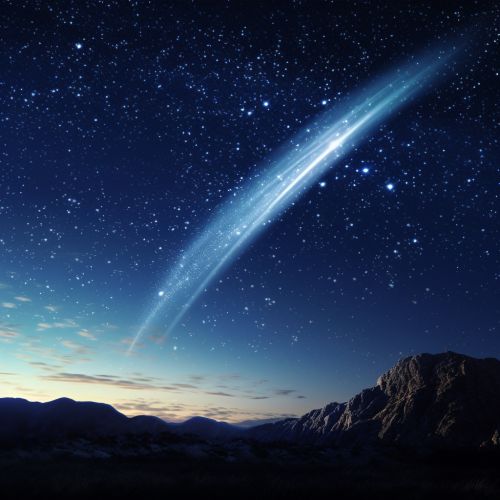Comet
Introduction
A comet is a celestial body that orbits the sun and is primarily composed of ice and rock. When a comet gets close enough to the sun, the heat causes the ice to vaporize, creating a visible coma or envelope around the nucleus, along with a tail that always points away from the sun. The study of comets provides valuable information about the early solar system, as they are believed to be remnants from this era.
Composition and Structure
Comets are made up of a mixture of water ice, frozen gases, rock, and dust. The solid part of a comet, known as the nucleus, is typically a few kilometers in diameter and has a dark surface that reflects very little sunlight. The nucleus is made up of a rocky core surrounded by ice. When the comet is far from the sun, the nucleus remains frozen and inactive. However, as the comet approaches the sun, the heat causes the ice to sublimate, or turn directly from a solid to a gas. This creates a cloud of gas and dust around the nucleus, known as the coma. The solar wind causes this material to stream out behind the comet, forming a tail. The tail of a comet can extend millions of kilometers into space, and it always points away from the sun due to the pressure of the solar wind.


Classification
Comets are classified based on their orbital characteristics. There are two main types of comets: short-period comets and long-period comets. Short-period comets have orbits that take them around the sun in less than 200 years. These comets are also known as periodic comets, and they are thought to originate from the Kuiper belt, a region of the solar system beyond the orbit of Neptune. Long-period comets have orbits that take them around the sun in more than 200 years, and they are believed to originate from the Oort cloud, a distant spherical shell of icy bodies surrounding the solar system.
Observation and Study
Comets have been observed and studied for thousands of years. Ancient cultures often viewed comets as omens or portents, and they feature in the records of many civilizations. With the invention of the telescope, astronomers were able to study comets in more detail. Today, comets are observed with both ground-based and space-based telescopes. Spacecraft have also been sent to study comets up close. These missions have provided valuable information about the composition and structure of comets, as well as about the early history of the solar system.
Notable Comets
There have been many notable comets throughout history. One of the most famous is Halley's comet, which is a short-period comet that orbits the sun every 76 years. It is the only short-period comet that is clearly visible to the naked eye, and it has been observed and recorded by humans for over two thousand years. Another notable comet is Hale-Bopp, which was visible to the naked eye for a record 18 months in 1996 and 1997. More recently, the Rosetta mission by the European Space Agency made history by landing a probe on the surface of a comet, 67P/Churyumov–Gerasimenko, for the first time.
Conclusion
Comets are fascinating celestial bodies that provide a window into the early solar system. Their spectacular appearances in the night sky have captivated humans for thousands of years, and they continue to be the subject of scientific study. As we continue to observe and explore these icy visitors from the outer reaches of our solar system, we will undoubtedly learn more about our own place in the cosmos.
